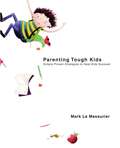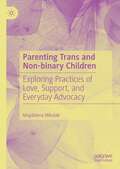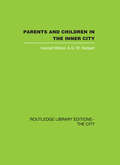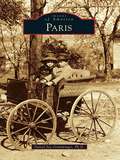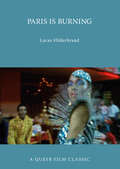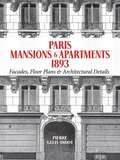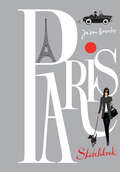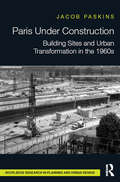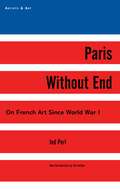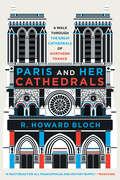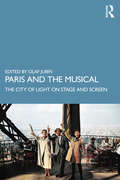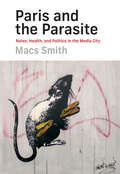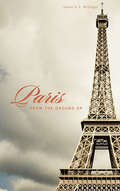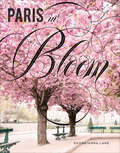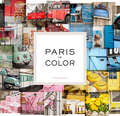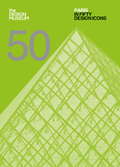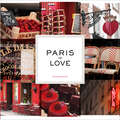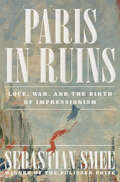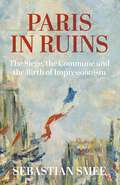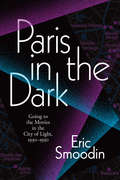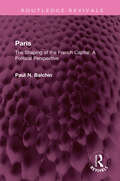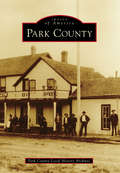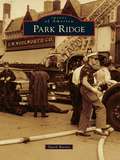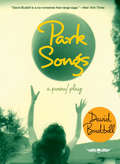- Table View
- List View
Parenting Tough Kids: Simple Proven Strategies to Help Kids Succeed
by Mark Le MessurierParenting Tough Kids delivers simple, proven strategies to improve the behavior, organization, learning, and emotional well-being of all children.Parents will find case studies and practical ideas to help youngsters improve memory and organization, complete homework and chores more easily, deal with school bullies, build emotional resilience, and create healthy friendships.
Parenting Trans and Non-binary Children: Exploring Practices of Love, Support, and Everyday Advocacy
by Magdalena MikulakBased on interviews conducted with parents of trans and gender diverse children in the UK, this book presents an account and analysis of the love, support, and advocacy involved in parenting trans and gender diverse children. Mikulak explores how parents negotiate and challenge cis-normativity to make familial, educational, and healthcare settings livable for their trans and gender diverse children. By examining the educational and emotional labor that parents perform as they advocate for their children across these different settings, the book highlights the value of parental expertise and labor while calling out the systemic failures that continue to make this work necessary. This research will be of interest to scholars researching family studies, kinship studies, gender studies, and queer studies.
Parents and Children in the Inner City
by Harriett Wilson G.W. HerbertThis book was first published in 1978.
Paris (Images of America)
by Daniel Jay GrimmingerIn 1806, Rudolph Bair came to Ohio from Pennsylvania and settled on one of the highest points in Stark County and called it Paris. After its establishment in 1814, this town became an important center of business and the arts. As a stagecoach stop on the main road from Pittsburgh to the West, this village evolved into a hub of American culture. By the late 1800s, Paris had dry goods stores, a drug store, two hotels, wagon factories, harness shops, shoe shops, blacksmith shops, a meat market, mills, a vinegar factory, and three churches. Local farmers also came to Paris to do business, worship in Paris's churches, and absorb the latest news. The legacy of this village and its surrounding farmland lives on here in photographs, artifacts, and descendents of early settlers.
Paris Is Burning
by Lucas HilderbrandParis Is Burning (Jennie Livingston, 1991) captures the energy, ambition, wit, and struggle of African-American and Latino participants in the 1980s New York drag ball scene. This book contextualizes the film within the longer history of drag balls, the practices of documentary, the fervor of the culture wars, and the development of queer theory and critical race studies.
Paris Mansions and Apartments 1893: Facades, Floor Plans and Architectural Details (Dover Architecture)
by Pierre Gelis-DidotSelected from a very rare portfolio, this volume presents exquisitely detailed engravings of Parisian apartment buildings and mansions of the late nineteenth century. Its 100 plates depict 50 buildings in the richly ornamented Beaux-Arts Classical style. These illustrations are the work of Pierre Gelis-Didot, who is celebrated for his architectural drawings. They depict buildings by such distinguished architects as Jean-Louis Pascal, Albert Walwein, Lucien Magne, Charles Girault, and others.Full-page illustrations of each facade are accompanied by facing pages with finely rendered architectural details, including floor plans, cross sections, and close-ups of doors, windows, and balconies. Other details include soaring arches, elaborate cornices, decorative trims, and colossal columns. From the boulevards of Saint-Germain, Haussmann, and Montparnasse to the Bois de Boulogne, this volume offers a celebration of residential architecture in the City of Light.
Paris Sketchbook
by Jason BrooksParis Sketchbook is a stunning gift book from leading international fashion illustrator Jason Brooks. Although he is best known for his beautiful fashion imagery, which has regularly graced the pages of Vogue and Elle magazines, travel has been a recurrent theme in his work and his adventures continue to inspire and inform his visual repertoire. During his time on fashion assignments at the couture shows in Paris, Brooks developed a fascination for the city, drawing and painting beautiful travel journals that demonstrate his passion for all things Parisian. This book is a whimsical take on Paris, part guide book, part illustrated journal, it will appeal to both travellers and fashionistas. Sumptuous production with different stocks and inks will make this a must for anyone who loves fashion illustration and beautiful books.
Paris Sketchbook: Jason Brooks
by Jason BrooksParis Sketchbook is a stunning gift book from leading international fashion illustrator Jason Brooks. Although he is best known for his beautiful fashion imagery, which has regularly graced the pages of Vogue and Elle magazines, travel has been a recurrent theme in his work and his adventures continue to inspire and inform his visual repertoire. During his time on fashion assignments at the couture shows in Paris, Brooks developed a fascination for the city, drawing and painting beautiful travel journals that demonstrate his passion for all things Parisian. This book is a whimsical take on Paris, part guide book, part illustrated journal, it will appeal to both travellers and fashionistas. Sumptuous production with different stocks and inks will make this a must for anyone who loves fashion illustration and beautiful books.
Paris Under Construction: Building Sites and Urban Transformation in the 1960s
by Jacob PaskinsDuring the 1960s, building sites in Paris became spaces that expressed preoccupations about urban transformation, labour immigration and national identity. As new buildings and infrastructure changed the city, building sites revealed the substandard living and working conditions of migrant construction workers in France. Moreover, construction was the touchstone in debates about the dangers of urban life, and triggered action in communities whose districts faced demolition. Paris Under Construction explores the social, political and cultural responses to construction work and urban transformation in the Paris metropolitan region during the 1960s. This examination of a decade of intensive building work considers the ways in which the experience of construction was mediated, produced and reproduced through a range of complex and sometimes contradictory representations. The building sites that produced the new Paris are no longer visible, and were perhaps never intended to be seen, yet different groups closely observed and recorded construction, giving it meanings that went beyond specific building activities. The research draws extensively on French newspaper, television and radio archives, and delves into rarely examined trade union material. Paris Under Construction gives voice to the witnesses of—and participants in—urban transformation who are usually excluded from architectural and urban history.
Paris Without End: On French Art Since World War I (Artists & Art)
by Jed PerlThis brilliant blend of history, biography, and criticism explores the seminal figures of twentieth-century French art-Matisse, Picasso, Derain, Léger, Dufy, Braque, Giacometti, Balthus, and Hélion-and the vital art world in which they thrived.The ten interlocking essays in this important book include radical new evaluations of Derain, Léger, and Dufy, and penetrating studies of the final works of Picasso and Braque. Paris Without End, Jed Perl's first book, is now celebrating its twenty-fifth anniversary and is essential reading for anyone passionate about modern art.Roberta Smith called it "a quiet, cogent tour de force. . . . As one critic's demonstration of what he considers the best in art and the best way to write about it, this book sets a high standard."Hilton Kramer also noted, "Everyone who cares about the art of the twentieth century will find something to disagree with in this book-its many unorthodox judgments are bound to be controversial-but that, in my view, is a mark of the book's importance."
Paris and Her Cathedrals
by R. Howard BlochFor history readers, travelers, and scholars alike, an indispensable behind-the-scenes guide to the great cathedrals of Paris. “So infectious is R. Howard Bloch’s passion for his subject that even those unable to do the traveling required will find in Paris and Her Cathedrals an inspiring guide to these time-hallowed masterpieces of medieval culture.” —Colin Jones, author of Paris and The Great Nation Over the years, R. Howard Bloch has become renowned for the insider tours of Paris that he gives to students abroad. Long sought after by travelers and history buffs for his near-encyclopedic knowledge of French cathedrals, the eminent French literature scholar finally shares his expertise with a wider audience. In Paris and Her Cathedrals, six of the most sublime cathedrals in the penumbra of Paris—Saint-Denis, Notre-Dame, Chartres, Sainte-Chapelle, Amiens, Reims—are illumined in magnificent detail as Bloch, taking us from the High Middle Ages to the devastating fire that set Notre-Dame ablaze in 2019, traces the evolution of each in turn. Written from the premise that “seeing is enhanced by knowing,” each chapter is organized along the lines of a walk around and then through the space of the cathedral, such that the actual or virtual visitor feels the rich sweep of the church, “the essence of these architectural wonders” (Antonia Felix). Animating the past with lush evocations of architectural splendor—from flying buttresses and jewel-encrusted shrines to hidden burial grounds and secret chambers—Bloch then contextualizes the cathedrals within the annals of French history. Here thrilling tales of kingly intrigue—as in Saint-Chapelle, where the pious King Louis IX amassed relics, including Christ’s crown of thorns—and audacious abbots are interspersed with anecdotes about the meeting of aristocratic and everyday life, culminating in “a rich, colorful narrative that clearly but expertly explains the history and symbolism of some of the world’s most magnificent buildings” (Ross King). To be read in preparation for an enlightened visit or merely to open a window upon the High Middle Ages in France, Paris and Her Cathedrals is a “revelation,” an “indispensable guide” (Garry Wills) to these awe-inspiring structures. Complete with the author’s own photographs, this beautifully illustrated volume vitally enhances our understanding of the history of Paris and its environs.
Paris and the Musical: The City of Light on Stage and Screen
by Olaf JubinParis and the Musical explores how the famous city has been portrayed on stage and screen, investigates why the city has been of such importance to the genre and tracks how it has developed as a trope over the 20th and 21st centuries. From global hits An American in Paris, Gigi, Les Misérables, Moulin Rouge! and The Phantom of the Opera to the less widely-known Bless the Bride, Can-Can, Irma la Douce and Marguerite, the French capital is a central character in an astounding number of Broadway, Hollywood and West End musicals. This collection of 18 essays combines cultural studies, sociology, musicology, art and adaptation theory, and gender studies to examine the envisioning and dramatisation of Paris, and its depiction as a place of romance, hedonism and libertinism or as ‘the capital of the arts’. The interdisciplinary nature of this collection renders it as a fascinating resource for a wide range of courses; it will be especially valuable for students and scholars of Musical Theatre and those interested in Theatre and Film History more generally.
Paris and the Parasite: Noise, Health, and Politics in the Media City
by Macs SmithThe social consequences of anti-parasitic urbanism, as efforts to expunge supposedly biological parasites penalize those viewed as social parasites.According to French philosopher Michel Serres, ordered systems are founded on the pathologization of parasites, which can never be fully expelled. In Paris and the Parasite, Macs Smith extends Serres's approach to Paris as a mediatic city, asking what organisms, people, and forms of interference constitute its parasites. Drawing on French poststructuralist theory and philosophy, media theory, the philosophy of science, and an array of literary and cultural sources, he examines Paris and its parasites from the early nineteenth century to today, focusing on the contemporary city. In so doing, he reveals the social consequences of anti-parasitic urbanism.
Paris from the Ground Up (From The Ground Up Ser. #10)
by James H. McGregorParis is the most personal of cities. There is a Paris for the medievalist, and another for the modernist—a Paris for expatriates, philosophers, artists, romantics, and revolutionaries of every stripe. James H. S. McGregor brings these multiple perspectives into focus throughout this concise, unique history of the City of Light. His panorama begins with an ancient Gallic fortress on the Seine, burned to the ground by its own defenders in a vain effort to starve out Caesar’s legions. After ninth-century raids by the Vikings ended, Parisians expanded the walls of their tiny sanctuary on the Ile de la Cité, turning the river’s right bank into a thriving commercial district and the Rive Gauche into a college town. Gothic spires expressed a taste for architectural novelty, matched only by the palaces and pleasure gardens of successive monarchs whose ingenuity made Paris the epitome of everything French. The fires of Revolution threatened all that had come before, but Baron Haussmann saw opportunity in the wreckage. No planned city in the world is more famous than his. Paris from the Ground Up allows readers to trace the city’s evolution in its architecture and art—from the Roman arena to the Musée d’Orsay, from the Louvre’s defensive foundations to I. M. Pei’s transparent pyramids. Color maps, along with identifying illustrations, make the city accessible to visitors by foot, Metro, or riverboat.
Paris in Bloom
by Georgianna Lane&“Get ready for a beauty overload. It&’s food for the soul, it&’s a book of dreams and details, of flowers so perfect you want to hug them to you.&” —Carla Coulson, author of Paris Tango Paris—City of Love, City of Light, City of Flowers. From elegant floral boutiques to lively flower markets to glorious blooming trees and expansive public gardens, flowers are the essential ingredient to the lush sensory bouquet that is Parisian life. With beautiful photography, Paris in Bloom transports readers on a stunning floral tour of the city, and provides recommendations to the best flower markets and a detailed guide to spring blooms. Timeless in content, Paris in Bloom is a book for Paris lovers to savor again and again, one to keep on the nightstand to conjure fond memories of their first visit and inspire dreams of the next. &“Brilliantly captures the splendor of French fleurs with lush photographs and elegant prose . . . A masterpiece!&” —Laura Dowling, former chief floral designer at the White House &“I don&’t know how Georgianna does it. She manages to make Paris, already the most beautiful city in the world, appear even more charming, more elegant and more beautiful than it already is . . . Paris in Bloom is filled with a veritable carpet of pinks and whites, pastels and green portraits that make me let out an audible sigh of joy. This book can re-inspire you to believe that yes, life really is quite beautiful.&” —Doni Belau, author of Paris Cocktails &“Destined to become a classic of its type, Paris in Bloom is Georgianna Lane&’s love letter to Paris and to flowers.&”—Gray Levett, editor of Nikon Owner magazine
Paris in Color
by Nichole RobertsonThe City of Light comes alive with color in this “fresh, ‘oh!’-inducing look at the palette of a city we only thought we knew” (Real Simple).Take a journey through the world’s most romantic city, traveling from color to magnificent color with this beguiling book. An orange café chair, bright blue bicycles against a fence, a weathered white door—Nichole Robertson’s sumptuous photographs of the distinctive details of Paris, all arranged by color, evoke a sense of serendipitous discovery and celebrate the city as never before. At once a work of art and a window into the heart of the city, Paris in Color will surprise and delight those who love art, design, color, and, of course, Paris!
Paris in Fifty Design Icons (Design Museum Fifty)
by Design Museum Enterprise Limited Brigitte Fitoussi Imogen FortesIn this series, the Design Museum looks at the fifty design icons of major cities around the world - icons that, when viewed together, inherently sum up the character of their city. Covering anything from buildings, monuments and iconic designers to a classic film or street sign, these books explore a tapestry of infamous designs, all with their own story to tell. One part design history, one part visual guidebook, this fascinating series unlocks the design stories of the biggest, most creative cities in the world. With entries on design icons from I.M. Pei's glass pyramid to the humble baguette, Le Monde newspaper to Le Corbusier's striking Maison La Roche, Paris in Fifty Design Icons builds an intricate portrait of Europe's most romantic city. With stunning photography, this book is the perfect gift for design enthusiasts and anyone who loves anything Parisian.Also available in the series: London in Fifty Design IconsNew York in Fifty Design IconsBerlin in Fifty Design Icons
Paris in Love
by Nichole RobertsonThe author of Paris in Color narrows her scope, celebrating the French capital with alluring and romantic photographs of the city&’s come-hither reds. A pair of scarlet-rimmed coffee cups, two glasses of Bordeaux, light glowing rosily from a street lamp, a bouquet of bright red flowers—Nichole Robertson&’s follow-up to the beloved Paris in Color captures the hidden corners and secret moments that make Paris the most romantic city in the world. A love letter in rouge to the City of Light, Paris in Love is the perfect valentine for anyone who adores Paris! &“A beautiful ode that will leave you pining for Paris.&” —Lindsey Tramuta, author of The New Paris &“That magic feeling you get when you are falling in love with a person or place—in this case Paris!—is encapsulated in this stunning gem of a book.&” —Samantha Hahn, author of Well-Read Women &“We&’re smitten by Nichole Robertson&’s Paris in Love, which celebrates all things Parisian—especially crimson things, from raspberry tarts to scarlet mopeds, rosy begonias and glossy, berry-hued cafe chairs—in glorious photographs.&” —San Jose Mercury News
Paris in Ruins: Love, War, and the Birth of Impressionism
by Sebastian SmeeA Boston Globe “20 Books We Can’t Wait to Read This Fall” A Next Big Idea Club “Must-Read Book for September 2024” The Pulitzer Prize–winning art critic’s gripping account of the “Terrible Year” in Paris and its monumental impact on the rise of Impressionism. From the summer of 1870 to the spring of 1871, famously dubbed the “Terrible Year” by Victor Hugo, Paris and its people were besieged, starved, and forced into surrender by Germans—then imperiled again as radical republicans established a breakaway Commune, ultimately crushed by the French Army after bloody street battles and the burning of central Paris. As renowned art critic Sebastian Smee shows, it was against the backdrop of these tumultuous times that the Impressionist movement was born—in response to violence, civil war, and political intrigue. In stirring and exceptionally vivid prose, Smee tells the story of those dramatic days through the eyes of great figures of Impressionism. Édouard Manet, Berthe Morisot, and Edgar Degas were trapped in Paris during the siege and deeply enmeshed in its politics. Others, including Pierre-August Renoir and Frédéric Bazille, joined regiments outside of the capital, while Claude Monet and Camille Pissarro fled the country just in time. In the aftermath, these artists developed a newfound sense of the fragility of life. That feeling for transience—reflected in Impressionism’s emphasis on fugitive light, shifting seasons, glimpsed street scenes, and the impermanence of all things—became the movement’s great contribution to the history of art. At the heart of it all is a love story; that of Manet, by all accounts the father of Impressionism, and Morisot, the only woman to play a central role in the movement from the start. Smee poignantly depicts their complex relationship, their tangled effect on each other, and their great legacy, while bringing overdue attention to the woman at the heart of Impressionism. Incisive and absorbing, Paris in Ruins captures the shifting passions and politics of the art world, revealing how the pressures of the siege and the chaos of the Commune had a profound impact on modern art, and how artistic genius can emerge from darkness and catastrophe.
Paris in Ruins: The Siege, the Commune and the Birth of Impressionism
by Sebastian SmeePulitzer-winner Sebastian Smee relives the remarkable birth of Impressionism from the ashes of war Paris, January 1871 – the final, agonising days of the Franco-Prussian War. As the German army cements its advantage, shells rattle through the Left Bank. It is a bitterly cold winter; there is no fuel, no medicine, no food. The city&’s poorer citizens have long turned to eating rats, cats and dogs. France has been brought to its knees. Édouard Manet, Berthe Morisot, and Edgar Degas are trapped in the besieged city. Renoir and Bazille have joined regiments outside of Paris, while Monet and Pissarro fled the country just in time. Out of the Siege and the Commune, these artists developed a newfound sense of the fragility of life. A feeling for transience – reflected in Impressionism&’s emphasis on fugitive light, shifting seasons, glimpsed street scenes, and the impermanence of all things – would change art history forever. This is the extraordinary account of the &‘Terrible Year&’ in Paris and its monumental impact on the rise of Impressionism.
Paris in the Dark: Going to the Movies in the City of Light, 1930–1950
by Eric SmoodinIn Paris in the Dark Eric Smoodin takes readers on a journey through the streets, cinemas, and theaters of Paris to sketch a comprehensive picture of French film culture during the 1930s and 1940s. Drawing on a wealth of journalistic sources, Smoodin recounts the ways films moved through the city, the favored stars, and what it was like to go to the movies in a city with hundreds of cinemas. In a single week in the early 1930s, moviegoers might see Hollywood features like King Kong and Frankenstein, the new Marlene Dietrich and Maurice Chevalier movies, and any number of films from Italy, Germany, and Russia. Or they could frequent the city's ciné-clubs, which were hosts to the cinéphile subcultures of Paris. At other times, a night at the movies might result in an evening of fascist violence, even before the German Occupation of Paris, while after the war the city's cinemas formed the space for reconsolidating French film culture. In mapping the cinematic geography of Paris, Smoodin expands understandings of local film exhibition and the relationships of movies to urban space.
Paris: The Shaping of the French Capital A Political Perspective (Routledge Revivals)
by Paul N. BalchinThis book offers a new perspective on French architecture, describing the impact of political history on the architectural development of Paris. Through various stages in history from the Roman to the Medieval, Renaissance and Early Modern and Modern, Paris: The Shaping of the French Capital shows how the immense political power of monarchs, the aristocracy and church determined the pace and volume of building in Paris and the extent of town planning. Whereas many other great cities owe their historic importance to trade, and to local government (the City of London being a supreme example), these attributes were largely absent in Paris (throughout most of its history it didn’t even have a mayor). Arguably, because of this, gradually over the centuries the French capital emerged as one of the world’s most beautiful cities, and now is a metropolis with a population in excess of 2 million.
Park County
by Park County Local History ArchivesCreated in 1861, Park County is one of Colorado's original 17 territorial counties. It is named after South Park, which is the vast, high alpine valley at the county's center. By the time the first fur trappers and explorers arrived in the early 1800s, Ute Indians had long visited the area to hunt the mountain valleys and fish the trout-filled streams. In 1859, prospectors discovered gold along Tarryall Creek, ushering in a mining boom that gave rise to dozens of boisterous mining camps. Ranchers soon followed, taking advantage of the nutritious native grasses and raising cattle to feed hungry miners, often under harsh conditions. By the 1880s, the Denver, South Park & Pacific and Colorado Midland Railroads arrived, spurring the growth of new towns and opening new markets for Park County's minerals, hay, ice, lumber, and cattle. As mining waned, tourism emerged as a major economic force attracting visitors eager to experience Park County's authentic character and stunning natural beauty.
Park Ridge (Images of America)
by Dave BarnesIn 1835, immigrants began to arrive from New York and New England to the area first called Pennyville, later renamed Brickton to reflect its leading industry, then finally incorporated as the Village of Park Ridge in 1873. The name originates from the village's park-like setting and an erroneous belief that the ridge at Johnston's Circle--today the three-way intersection of Touhy, Prospect, and Northwest Highway--was the highest point in Cook County. Notable names associated with Park Ridge include Secretary of State Hillary Clinton and actor Harrison Ford, who both attended Maine East High School; Chicago Cubs great Ron Santo, who operated a popular pizzeria in town; and painter Grant Wood, whose American Gothic is one of the 20th century's great works of Americana. Anchored by the landmark Pickwick Theater, a fine example of art deco architecture built in 1928, downtown Park Ridge has changed much over the years, a transformation captured so well in the pages of this book.
Park Songs
by David Budbill R. C. IrwinA "tale of the tribe" (Ezra Pound's phrase for his own longer work), Park Songs is set during a single day in a down-and-out Midwestern city park where people from all walks of life gather. In this small green space amidst a great gray city, the park provides a refuge for its caretaker (and resident poet), street preachers, retirees, moms, hustlers, and teenagers. Interspersed with blues songs, the community speaks through poetic monologues and conversations, while the homeless provide the introductory chorus--and all of their voices become one great epic tale of comedy and tragedy. Full of unexpected humor, hard-won wisdom, righteous (but sometimes misplaced) anger, and sly tenderness, their stories show us how people learn to live with mistakes and make connections in an antisocial world. As the poem/play engages us in their pain and joy--and the goofy delight of being human--it makes a quietly soulful statement about acceptance and community in our lives. David Budbill has worked as a carpenter's apprentice, short order cook, day laborer, and occasional commentator on NPR's All Thing Considered. His poems can often be heard on Garrison Keillor's Writer's Almanac and his books include the best-selling Happy Life (Copper Canyon Press) and Judevine, a collection of narrative poems that forms the basis for the play Judevine, which has been performed in twenty-two states. Born in Cleveland, Ohio, Budbill now lives in the mountains of northern Vermont. R. C. Irwin, whose absurdist and nostalgic work provides the set design for Park Songs, teaches at San Francisco City College.
